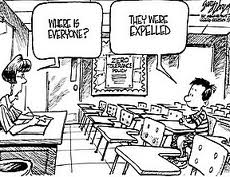Nonviolence Currents – Bridging Nonviolence and Current Events in the Classroom
A service of the Metta Center for Nonviolence
LESSON PLAN #4
 Waging Nonviolence Article: Students push to limit school police after Newtown
Waging Nonviolence Article: Students push to limit school police after Newtown
Themes: Restorative justice, state politics, school safety
Target age group: Ages 14 & up
Subject areas: Language Arts, Social Studies, Government
Pre-reading vocabulary check: Ask students to skim the article and look up unfamiliar words.
Pre-reading discussion: Discuss the current state of safety and discipline at your school.
-
What happened in Newtown, Connecticut that inspired this author to write this piece?
-
Identify some of the root causes of the epidemic of school shootings. Do school police address these root causes? Why or why not? What or who would address the root causes?
-
What measures are in place at our school to promote school safety? (school police, metal detectors, counselors, conflict resolution programs, peer mediation, etc.) Do you feel they are effective? Why or why not?
-
What disciplinary measures are commonly used at your school? (juvenile detention, arrest, out-of-school or in-school suspension, detention, etc.) Do you feel they are effective? Why or why not?

Reading: Set aside time in class to read the article (10-15 minutes) or assign the reading for homework the night before class.
Post-reading discussion:
1. In the article, student Carlo Elmo Gomez says, “We were always told, when the cops pulled us over, and even with teachers sometimes, that this is who you are, and this is where you’re going to end up.”
Comment on Gomez’s remark. Why do you think the question of “who we are” important when discussing nonviolent alternatives to violent systems?
2. a) Who is affected by violence in schools? List all parties.
b) How can all parties affected by an act of violence be included in the healing process? What happens when some parties are not included?
3. What are the alternatives to school police force that are discussed in the article? (restorative justice, conflict resolution programs, student involvement in school policy, etc.) Which alternatives inspire you? Why?
4. What is the “school to prison pipeline”? How does the National Dignity in Schools campaign address it? (read their statement) What would you add to their statement? Why?
5. In the wake of the epidemic of school and neighborhood shootings, what do you think should be the response at different levels? Think about action that can be taken by:
- Congress/the federal government
- Your state
- Your neighborhood
- Your school
- You
Extension 1: Individually, in small groups, or as a class, create either:
- A practical plan for school safety for your school or neighborhood. Based on your pre-reading discussion, what would you keep? What would you change? Why?
- An awareness-raising campaign or event that addresses root causes of school and neighborhood shootings
Extension 2: In small groups or individually, have students research legislation about school safety and discipline in your state. Consider reading AB549 mentioned in this article. Then write a report or make a presentation on the legislation. Alternatively, have students draft their own legislation, either adapting the current legislation or writing an entirely new plan.
Additional Reading and Resources:
-
The School-to-Prison Pipeline from Teaching Tolerance
- Dignity in Schools Classroom Resources
Lesson plan created and developed by Stephanie Knox Cubbon and Stephanie Van Hook of the Metta Center for Nonviolence.
If you have any questions about this lesson, or if you use it and would like to tell us about it, please write to use at education@mettacenter.org. We would love to hear from you!









